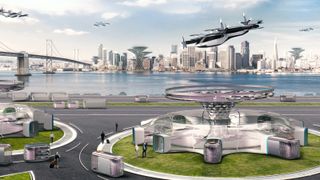Hyundai and Uber team up on flying electric taxis
Hey, it's your Uber pilot. Where we flying?

LAS VEGAS — You hear a lot about “smart cities” at CES, though it’s hard to imagine what one might actually look like. A partnership between Hyundai and Uber Elevate announced today (Jan. 6) gives us a better clue as to how public transportation could shake out in a more connected future.
You might be wondering what Hyundai, the Korean automaker, is doing getting involved with Uber Elevate, which is dedicated to aerial ride-sharing. That’s where Hyundai’s Urban Air Mobility concept, teased in the run-up to CES 2020, comes in.
The UAM is an all-electric aircraft designed with services like Uber in mind. The craft can take off and land vertically, critical in cities where space is constrained. Hyundai says the UAM concept it has developed would likely be manned by a pilot at launch, although the company envisions a version that is autonomous one day.
In theory, the UAM would dock at an S-Hub, a station designed for both air and ground travel, that would also support Hyundai’s other public transportation concept, the Airstream-shaped Purpose Built Vehicle, or PBV. Ideally, the PBV would be a modular space on wheels that could serve many purposes — from a rolling cafe, to a medical clinic in the event of emergencies.

Obviously, Hyundai's pitch here is more theoretical. It’s not the first time the company has come to CES with a non-functioning idea of future transportation that seems quite ambitious, to say the least. Last year, Hyundai introduced the Cradle prototype, a walking car designed to traverse terrain impossible for any car.
Likewise, the automaker doesn't expect that this particular UAM aircraft, named the S-A1, will make it to the market before 2029 at the earliest. That's far off indeed, though Uber is looking to fully roll out its air service by 2023. By the end of the decade, the market could be in need for a specialized air taxi like what Hyundai's previewed here.
Much of the UAM's appeal seems nice in theory, despite all the challenges facing such a massive infrastructural and regulatory undertaking. The aircraft would supposedly be able to seat five (including the pilot) and travel up to 200 mph. That seems like overkill for the relatively short distances you’d be going within a city, though Hyundai says that the UAM would be ideal for traveling longer distances as well, across suburbs. In fact, the company estimated that a 90 minute commute in an urban environment could be reduced to just 10 minutes.
Sign up to get the BEST of Tom’s Guide direct to your inbox.
Upgrade your life with a daily dose of the biggest tech news, lifestyle hacks and our curated analysis. Be the first to know about cutting-edge gadgets and the hottest deals.
Like last year's Cradle, CES attendees will find a full-size design model of the UAM at Hyundai’s booth at CES 2020. A scale model was featured on stage during Hyundai’s press conference.
Be sure to check out our CES 2020 hub for the latest news and hands-on impressions out of Las Vegas.
Adam Ismail is a staff writer at Jalopnik and previously worked on Tom's Guide covering smartphones, car tech and gaming. His love for all things mobile began with the original Motorola Droid; since then he’s owned a variety of Android and iOS-powered handsets, refusing to stay loyal to one platform. His work has also appeared on Digital Trends and GTPlanet. When he’s not fiddling with the latest devices, he’s at an indie pop show, recording a podcast or playing Sega Dreamcast.
